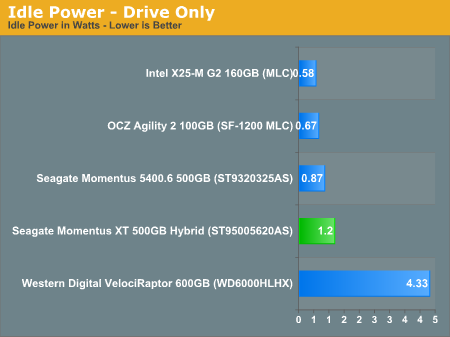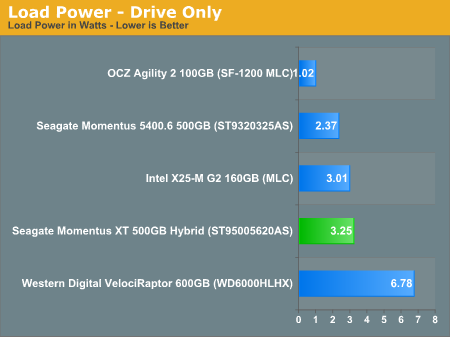Seagate's Momentus XT Reviewed, Finally a Good Hybrid HDD
by Anand Lal Shimpi on May 24, 2010 9:31 AM EST- Posted in
- Storage
- SSDs
- Seagate
- Momentus XT
- Hybrid Drive
- SSHDs
Power Consumption
Compared to the Seagate Momentus 5400.6 the XT uses considerable more power. Only when reading out of the NAND would I expect lower power consumption. What this means is that depending on your workload you might see worse notebook battery life with the Momentus XT compared to a mainstream drive. For the majority of usage models I'd expect equal if not better battery life with the Momentus.

With only the NAND active the Momentus XT draws as little as 0.61W.

Compared to an high end SSD though, the Momentus XT is still more power hungry.










120 Comments
View All Comments
dannysauer - Saturday, July 2, 2011 - link
That's a terrible metaphor. A "100 shot" of nitrous is called a "100 shot" because it's good for 100 horsepower. Dyno tests on properly tuned vehicles repeatedly confirm that the advertised power change is usually within a few HP of the documentation.Now that I think about it, I guess it's inadvertently a good metaphor for poorly understanding technology. :)
In any event, you have a good point that it's deceptive to market this as a "hybrid". It's just a regular drive with a large intelligent cache. They should just say "now! with adaptive caching!" or something.
Chloiber - Monday, May 24, 2010 - link
In the beginning you said you would use a Patriot Inferno, but on most benchmarks it says "Agility 2" ?!OT:
This drive should be a perfect upgrade for all notebook users who think SSDs are too expensive or who need more space than the usual 40-120GB of SSDs.
Anand Lal Shimpi - Monday, May 24, 2010 - link
I only used the Inferno for the new tests, the rest was existing data pulled out of Bench. However the two drives perform the same, they are both SF-1200 based 100GB drives with production firmware :)Take care,
Anand
Chloiber - Monday, May 24, 2010 - link
Ah, no problem then, thought it's a copy&paste error :)Aikouka - Monday, May 24, 2010 - link
What I'm curious about is how this drive handles regularly used files that change somewhat often. Caching can be great for executables or libraries (DLLs, etc), given that they don't change often if at all. But what happens when you have files that are accessed during a specific task that may change every time you perform this task? You said that the algorithm doesn't work with writes, which if it understood what write was coming in, it could intercept and possibly alter the already cached data to the new value.This mostly came from a nerdy WoW example where while textures and such don't normally change too often, add-on settings can possibly change every time you load the game (and load-up can be pretty ardruous with a lot of add-ons). So, if these settings files are changing possibly every time, the cache values will be out of date and it'll have to use its poor Random Read rate to access the proper data.
It's really just one drop in the bucket of the many examples you can think of where this drive wouldn't have a problem, but start-up time in WoW is one of the reasons why I went with the Intel X25-M to begin with... when I bought it, it was pretty much top notch in random read performance.
Anand Lal Shimpi - Monday, May 24, 2010 - link
As is the case with any cache there has to be some mechanism to invalidate data in the cache if the original data is modified. I believe that's what happens here. There's a table of LBAs that are cached and if one is modified then the cached version is immediately invalidated and/or updated.Take care,
Anand
Aikouka - Monday, May 24, 2010 - link
Definitely true with cache invalidating.I think I was reading a bit too far into this line:
"the Momentus XT however, the SLC NAND acts exclusively as a read cache - writes never touch the NAND."
and considering that it meant that the caching wouldn't access incoming writes for validating cached data. It sounded odd that way as it'd make caching an absolute sleeping bear of a problem. I'm assuming the statement is meant to be taken literally -- the drive simply doesn't write cache to help speed up writes.
Thanks for the clarification on a sleepy Monday morning and bienvendo!
siberian 3 - Monday, May 24, 2010 - link
Hi Anand do we know what will happen if the NAND fail and not the mechanical part of the drive?Will the user lose the DATA it is on the drive
jaydee - Monday, May 24, 2010 - link
Anand, how do you think this would compare if they chose to do, say 8GB of MLC instead of 4GB of SLC? Surely it would bring the cost down, and I would think the double cache would be more important than the decrease in speed?Chloiber - Monday, May 24, 2010 - link
It has also something to do with reliability/lifetime, not just performance.